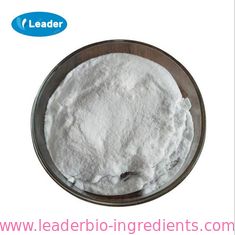
China Northwest Factory Manufacture N-Acetylneuraminic acid/SIALIC ACID Cas 131-48-6 For Health Industry Use
-
ColorWhite
-
UseHealth Care
-
OriginChina
-
Package1KG/Tin 25KG/Drum*Carton
-
ManufacturerXI'AN LEADER BIOCHEMICAL ENGINEERING CO.,LTD
-
Place of OriginCHINA
-
Brand NameLeader
-
CertificationISO,GMP,SGS
-
Model NumberLD-01582
-
Minimum Order Quantity100KGS
-
PriceUSD800-1000/KG
-
Packaging Details25KG/Drum
-
Delivery Time2-3 working days
-
Payment TermsWestern Union, MoneyGram, T/T, L/C
-
Supply Ability5MTS/Month
China Northwest Factory Manufacture N-Acetylneuraminic acid/SIALIC ACID Cas 131-48-6 For Health Industry Use
| N-Acetylneuraminic acid Usage And Synthesis |
| Description | Sialic acid is a generic term for the N- or O-substituted derivatives of neuraminic acid, a monosaccharide with a nine-carbon backbone.It is also the name for the most common member of this group, N- acetylneuraminic acid ( Neu 5Ac or NANA). Sialic acids are found widely distributed in animal tissues and to a lesser extent in other species, ranging from plants and fungi to yeasts and bacteria, mostly in glycoproteins and gangliosides. The amino group generally bears either an acetyl or glycolyl group, but other modifications have been described. The hydroxyl substituents may vary considerably; acetyl, lactyl, methyl, sulfate, and phosphate groups have been found. The term "sialic acid" (from the Greek for saliva, σ?αλον/sialon) was first introduced by Swedish biochemist Gunnar Blix in 1952. |
| Chemical Properties | N-acetylneuraminic acid is an N-acyl derivative of neuraminic or acid amino sugar derivative, derived from N-acetylmannosamine and pyruvic acid. It is an important constituent of glycoproteins and glycolipids. N-acetylneuraminic acid occurs in many polysaccharides, glycoproteins, and glycolipids in animals and bacteria. |
| Physical properties | The numbering of the sialic acid structure begins at the carboxylate carbon and continues around the chain. The configuration which places the carboxylate in the axial position is the alpha-anomer. The alpha-anomer is the form that is found when sialic acid is bound to glycans, however, in solution it is mainly (over 90 %) in the beta-anomeric form. A bacterial enzyme with sialic acid mutarotase activity, NanM, has been discovered which is able to rapidly equilibrate solutions of sialic acid to the resting equilibrium position of around 90 % beta 10 % alpha. |
| Uses | Carbon 13 labelled analogue of N-Acetylneuraminic acid (A187000). |
| Biosynthesis | In bacterial systems, sialic acids are biosynthesized by an aldolase enzyme. The enzyme uses a mannose derivative as a substrate, inserting three carbons from pyruvate into the resulting sialic acid structure. These enzymes can be used for chemoenzymatic synthesis of sialic acid derivatives. |
| Biological Functions | Sialic acid-rich glycoproteins (sialoglycoproteins) bind selectin in humans and other organisms. Metastatic cancer cells often express a high density of sialic acid-rich glycoproteins. This overexpression of sialic acid on surfaces creates a negative charge on cell membranes. This creates repulsion between cells (cell opposition) and helps these late-stage cancer cells enter the blood stream. Sialic acid also plays an important role in human influenza infections. Many bacteria also use sialic acid in their biology, although this is usually limited to bacteria that live in association with higher animals (deuterostomes). Many of these incorporate sialic acid into cell surface features like their lipopolysaccharide and capsule, which helps them evade the innate immune response of the host.[6] Other bacteria simply use sialic acid as a good nutrient source, as it contains both carbon and nitrogen and can be converted to fructose-6- phosphate, which can then enter central metabolism. Sialic acid-rich oligo saccharides on the glyco conjugates ( glyco lipids, glyco proteins, proteoglycans) found on surface membranes help keep water at the surface of cells . The sialic acid - rich regions contribute to creating a negative charge on the cells' surfaces. Since water is a polar molecule with partial positive charges on both hydrogen atoms, it is attracted to cell surfaces and membranes. This also contributes to cellular fluid uptake. Sialic acid can "hide" mannose antigens on the surface of host cells or bacteria from mannose - binding lectin . This prevents activation of complement. Sialic acid in the form of poly sialic acid is an unusual posttranslational modification that occurs on the neural cell adhesion molecules (NCAMs). In the synapse, the strong negative charge of the polysialic acid prevents NCAM cross-linking of cells. |



